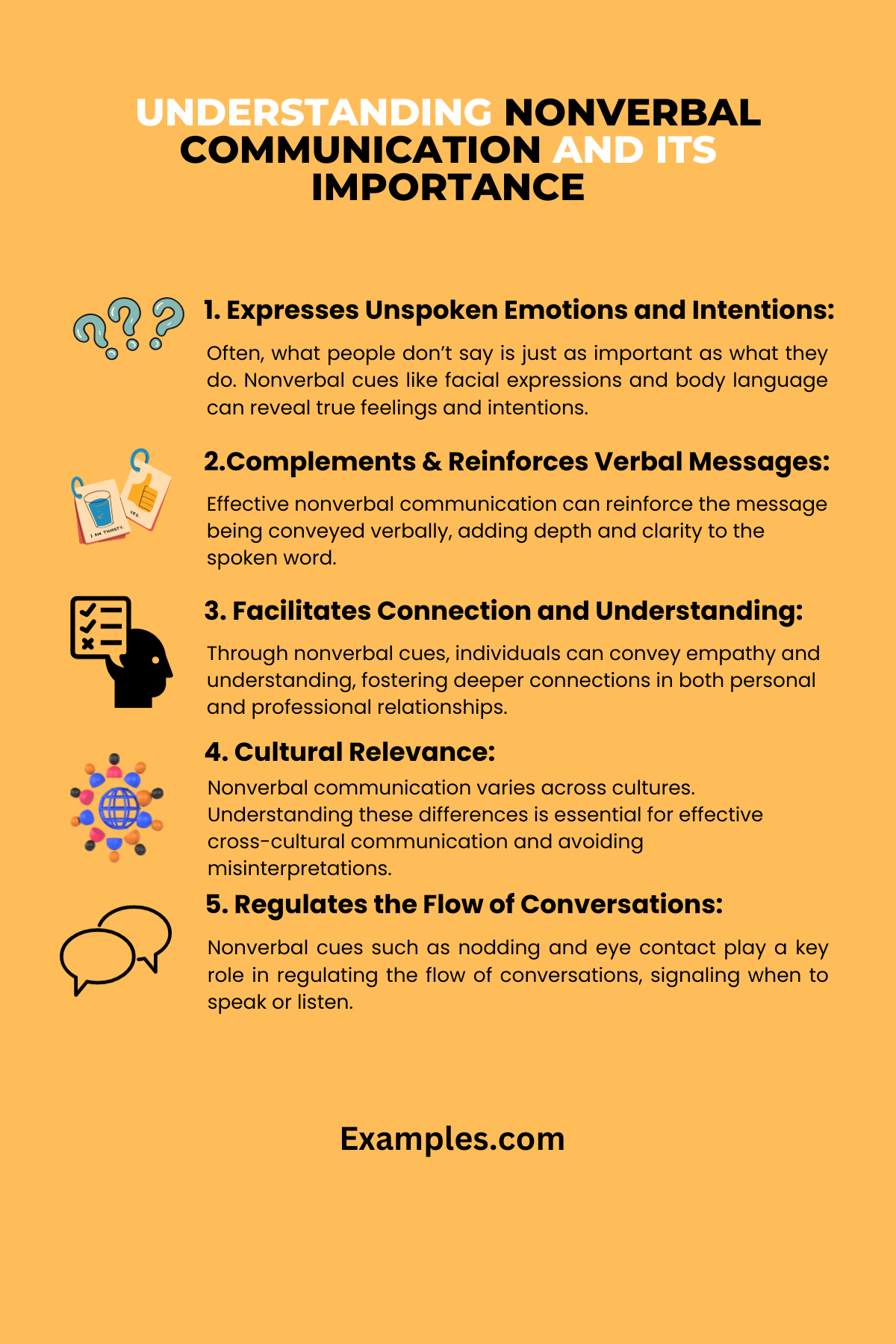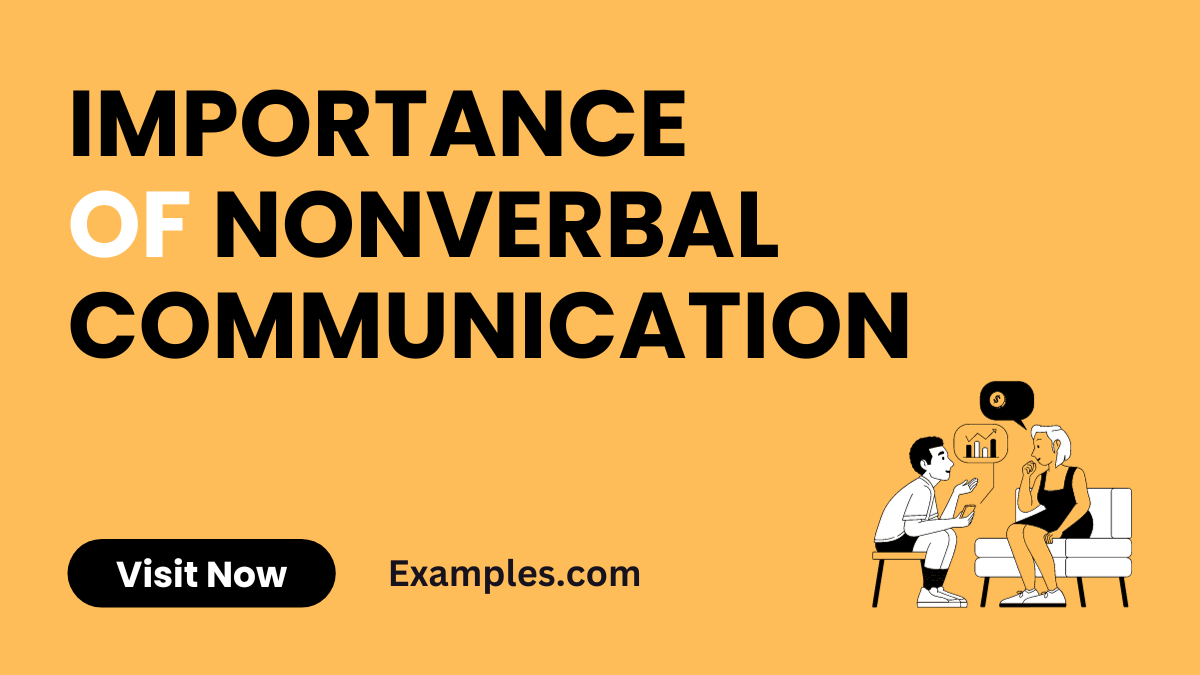Importance of Nonverbal Communication
Nonverbal communication plays a crucial role in how we convey and interpret messages. This comprehensive guide delves into the myriad ways nonverbal cues impact our interactions. From facial expressions to body language, understanding Nonverbal Communication Examples is key to effective communication. Whether in personal conversations or professional settings, this guide offers valuable insights and practical examples to enhance your nonverbal communication skills, ensuring your message is not just heard, but also understood.
What is The Importance of Nonverbal Communication?
Nonverbal communication refers to the ways we convey messages without using words. This includes facial expressions, body language, gestures, eye contact, and even the tone of our voice. It’s a fundamental aspect of human interaction, often conveying more meaning than spoken words. Understanding nonverbal communication is essential because it helps us interpret what others are really saying and allows us to express ourselves more effectively. It’s not just about what we say, but how we say it, making nonverbal cues a powerful tool in understanding and improving our interactions with others.
Why It’s Important to Clarify Nonverbal Communication
Clarifying Nonverbal Communication is crucial in ensuring effective and accurate communication. Often, the unspoken elements of a conversation, such as body language or facial expressions, carry significant meaning. Misinterpreting these cues can lead to misunderstandings and conflicts. By understanding and clarifying these nonverbal signals, we can enhance our interactions, foster better relationships, and ensure that our true intentions and feelings are understood.
Clarifying Nonverbal Communication is a critical aspect of effective interpersonal interactions for several reasons:
- Reduces Misinterpretations: Nonverbal cues, such as facial expressions or body language, can be open to different interpretations. Clear understanding and clarification of these cues help in reducing misunderstandings, particularly in important conversations.
- Strengthens Verbal Messages: Nonverbal communication often complements or emphasizes verbal communication. Ensuring that nonverbal cues align with verbal messages strengthens the overall communication, making it more coherent and impactful.
- Improves Cross-Cultural Communication: Given the cultural variations in nonverbal communication, clarifying these cues becomes essential in multicultural settings. What is considered polite in one culture might be offensive in another, making clarification vital for respectful and effective communication.
- Enhances Emotional Intelligence: The ability to correctly interpret and clarify nonverbal cues is a key component of emotional intelligence. It enables individuals to respond appropriately to the unspoken feelings and attitudes of others, thereby improving the quality of interactions.
- Facilitates Trust and Rapport: Clear and consistent nonverbal communication fosters trust. When people understand each other’s nonverbal cues, it leads to better rapport and a stronger connection.
In summary, the Importance of Nonverbal Communication is paramount as it greatly influences the effectiveness of our interactions. Whether in personal relationships, professional environments, or cross-cultural settings, clarifying nonverbal cues ensures that the intended message is accurately conveyed and received.
Understanding Nonverbal Communication and Its Importance

Understanding the nuances of Nonverbal Communication is vital for successful interactions. It involves more than just words; it encompasses facial expressions, body language, tone of voice, and even silence. These elements play a significant role in conveying messages and emotions. Recognizing the Importance of Nonverbal Communication helps in interpreting these unspoken cues correctly, leading to more meaningful and effective communication in both personal and professional contexts.
Nonverbal Communication encompasses a variety of cues and signals beyond spoken words. Understanding its importance is crucial for several reasons:
- Expresses Unspoken Emotions and Intentions: Often, what people don’t say is just as important as what they do. Nonverbal cues like facial expressions and body language can reveal true feelings and intentions.
- Complements and Reinforces Verbal Messages: Effective nonverbal communication can reinforce the message being conveyed verbally, adding depth and clarity to the spoken word.
- Facilitates Connection and Understanding: Through nonverbal cues, individuals can convey empathy and understanding, fostering deeper connections in both personal and professional relationships.
- Cultural Relevance: Nonverbal communication varies across cultures. Understanding these differences is essential for effective cross-cultural communication and avoiding misinterpretations.
- Regulates the Flow of Conversations: Nonverbal cues such as nodding and eye contact play a key role in regulating the flow of conversations, signaling when to speak or listen.
Understanding the Importance of Nonverbal Communication equips individuals with the ability to interpret and use these unspoken cues effectively, enhancing their overall communication skills.
Importance of Nonverbal Communication in Interaction

The Importance of Nonverbal Communication in Interaction cannot be overstated. Nonverbal cues such as gestures, facial expressions, and posture play a crucial role in how we interpret messages and respond to others. These cues often reveal more than verbal communication, influencing how we connect and build rapport. Understanding these nonverbal elements is essential for effective communication, as they significantly impact the dynamics of our interactions.
The Importance of Nonverbal Communication in Interaction is multifaceted:
- Enhances Interpersonal Communication: Nonverbal cues provide additional information that complements verbal communication, making interactions more meaningful and effective.
- Reflects Emotional State and Attitudes: These cues often convey emotions more genuinely than words can, offering insights into a person’s true feelings and attitudes.
- Builds Rapport and Trust: Effective nonverbal communication can help build rapport and establish trust in various relationships, whether personal or professional.
- Facilitates Non-Verbal Feedback: In interactions, nonverbal feedback like nodding or facial expressions provides immediate and often instinctive responses to communication, helping the speaker gauge the listener’s reactions.
- Bridges Language Barriers: In situations where language barriers exist, nonverbal communication can serve as a universal language, helping convey messages where words fall short.
The Importance of Nonverbal Communication in interactions lies in its power to convey messages and emotions that words alone cannot, making it an integral part of effective communication.
In conclusion, the Importance of Nonverbal Communication is undeniable in enriching interactions and relationships. This guide has equipped you with essential insights and tips to effectively interpret and convey nonverbal cues. Embracing these skills will not only enhance your understanding of Nonverbal Communication but also empower you to communicate more effectively in a multitude of personal and professional settings.



